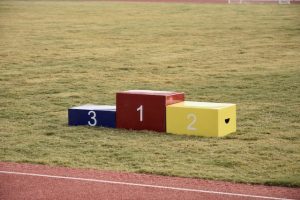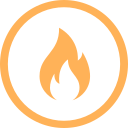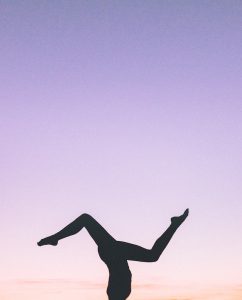Stepping Stone 8: Indigenous Peoples’ Achievements in Movement
by Dr. Rosalin Miles
Introduction

Indigenous people on Turtle Island have been champions in physical activity for thousands of years to survive off of the land. This physical prowess is passed on from generation to generation. Prior to the competitive mainstream sports that we know today, the original people were successfully shaping their villages and homes with hard physical labour that changed with the needs of each season and generation. There would be people in the villages who excelled in physical accomplishments such as:
- War canoe battles
- Archery or spear throwing while hunting
- Harvesting large trees for homes or canoes
- Being a transient tribe that moved entire communities to be closer to food sources for harvest in spring or summer.
There are many Indigenous stories about physical achievements tied to power, strength, endurance, and other attributes that make great athletes or champions regardless of sex and/or gender or abilities. There are also some well-recognized athletes on Turtle Island that have excelled in movement and this Stepping Stone will highlight some of these past and present successes in physical movement for Indigenous peoples. As we move to the end of the Stepping Stones in this resource, it is important to recognize that the history of Indigenous people’s achievements is seldom recorded in written articles or photographs. This is due to colonization, and as such, there is a disconnect between achievements in Indigenous communities compared to what is featured in the news. All accomplishments of Indigenous people in movement – whether recorded formally or not – are positive, reverent, and meaningful. As this resource is a living document, we invite you to contribute and share more successes and continue to build the story. However, the current Stepping Stone is restricted to what is shared on the World Wide Web for reading, seeing and hearing.
Wholistic Learning Objectives
Stepping Stone 8 provides learners an opportunity to reflect on the past and present Indigenous people’s achievements in movement that include traditional sports and mainstream sport competitions.
Upon completion of Stepping Stone 8, learners should be able to:
*click through all 5 slides to read each of the wholistic learning objectives*
Warm-up Activity

Warming-up is an important component in preparation for activity that may require someone to be flexible in their physical movement.
-
-
-
- What does physical flexibility mean to you?
- Do you consider yourself a physically flexible person?
- Can you think of ways that physical flexibility may differ by community?
-
-
Take a moment and prepare by reflecting on what it must have felt like to come from a generation of warriors, hunters, and people strong and powerful in living off the land with a family-centered approach.
Let us be flexible in our understanding of what achievement in physical activity means.
A Look Back at Success
As discussed in Stepping Stone 7, prior to colonization, there was competition within and between Indigenous communities that resulted in successes that were seen as individual, team, or community achievements. Physical achievements in movement translated into feelings of success, recognition, and championship, but these physical challenges also supported training for life competition; to survive and to sustain the community way of life.
Sports competition existed before colonization, however, the settlers introduced new physical competitions and ways to recognize success in local, regional, national, and international games, tournaments, and events. During colonization and Indian residential school dominance, sport competition was a part of community activities. Through sport during this time, some Indigenous athletes may have found a place to associate with others, creating stronger connections within the new education, recreation, or sport systems that were forced upon them. The ability to participate in sporting events may have provided a place to connect with one’s warrior spirit again, and have a sense of community.
Watch: Our Ancestors Were Athletes (43:58)
Spotlight on Indigenous Achievement in Physical Activity
Watch: Careers That Matter: Rosalin Miles (Exec. Director, Indigenous Physical Activity & Cultural Circle) (20:04)
Activity 1
Watch the following video: The History of Tom Longboat (5:13)
- Describe Tom Longboat’s successes in physical activity and sport.
- Why were Tom Longboat’s achievements so remarkable during this time period?
Activity 2
Sharon and Shirley Firth are twin sisters from Gwich’in First Nation in the Northwest Territories who were the first Indigenous women to compete in 4 Olympic Games (1972, 1976, 1980, and 1984) in cross-country skiing (Canada’s Sports Hall of Fame, 2017).
Watch the following video: Sharon & Shirley Firth – Bow Valley Sports Hall of Fame 2017 Inductees (2:49)
- Why might it be more difficult for Indigenous women to hold recorded achievements in sports?
- What are some of the additional barriers that Indigenous women may experience in sport?
Activity 3
Read the following article on Colette Bourgonje:
CELEBRATING NATIONAL INDIGENOUS HISTORY MONTH: 11 FACTS ABOUT COLETTE BOURGONJE
- Reflecting on what you have learned about achievements in movement, how have Indigenous athletes demonstrated great resilience in the face of adversity?
Activity 4
Read the following article about Jesse Cockney:
- How does having Indigenous role models influence Jesse’s success?
Activity 5
Alwyn Morris is an athlete from Kahnawake Mohawk Nation who competed in the 1984 Olympic Games (Canadian Olympic Committee, n.d.-a). He was celebrated by Indigenous people for self-identifying on the podium when he held up an Eagle feather and was the first Indigenous person to receive a gold and bronze medal at the Olympic Games.
Read the following article about Alwyn Morris:
- Why was Alwyn’s self-identification on the podium so powerful for his community and the Nation?
Activity 6
Waneek Horn-Miller is a Mohawk athlete who competed in the 2000 Olympic and her story of resilience and championship is inspirational. Read the following article about Waneek Horn-Miller:
- How are Indigenous athletes motivated to continue to advocate for self-determination?
A Reflection on Indigenous Achievement
When reflecting on achievement in movement, it is clear that there are many Indigenous elite athletes who have participated in sports on an international stage such as the Olympic or Paralympic Games. When considering the success of Olympic or Paralympic athletes, training not only includes physicality, but it must also include mental and motivational training (Jako, 2014). From a strength–based perspective, most First Nations, Inuit, and Métis athletes have strong ties to history, culture, and traditions. This may provide an enhanced sense of belonging and ties to community resilience, and thus may lead to a more well-prepared, wholistic athlete. However, when reviewing mainstream lists of Indigenous athletes who have succeeded in sport (see e.g., Canada’s Olympic Network, 2020), the list is incomplete. There are far more Indigenous people who have competed and shared stories of their achievements within their community, which may not be at the Olympic level. Therefore, we feel that this Stepping Stone is incomplete. This Stepping Stone should continue to evolve and will grow as more Indigenous people are identified on International, National, Provincial, Territorial, and/or Community levels. While exploring the evidence and media on the accomplishments of Indigenous people in movement it is important to look at achievements at:
There are also regional events that may be organized by mainstream sport organizations where Indigenous people shine with success. Traditional Indigenous celebrations offer other examples of achievement in movement. For example, there are elite dancers in powwow, jingle dress, drumming, jigging, hoop, fancy, grass dance, and so on. Furthermore, there are Indigenous community events where traditional sports or other movement activities are celebrated and participants’ achievements are recognized but not necessarily medaled. All successes in movement must be celebrated; from an Indigenous way of knowing, physical achievements may not be accomplished without recognizing the other wholistic components and ties to spiritual, emotional, and mental wellness. It is important to consider that achievement in movement may be tied to “walking the talk” and having integrity with actions, thoughts, words, and beliefs. Achievement in movement may also be a physical skill or test that elicits endurance, stamina, strength, power, agility, flexibility, balance, speed, coordination, or accuracy. Achievements in movement may be individual or team-based, age-specific, be connected to a person’s sex or gender, categorized by level or abilities, and have ties to community or national origin. However, all achievements in movement are to be celebrated, from a child learning to ride a bike to an Elder who has passed on the teachings of drum dancing.
Wellness Break

Reflect on a time that you may have had achievements in physical movement, and when your goals were realized, how did you feel physically, spiritually, emotionally, and mentally?
Take this time to write down or share what physical activity or event you participated in. What motivated you to compete?
Are you still involved in this type of physical movement (sport, activity, etc.)? If you can, find time in the short-term to engage with this physical movement again. Even if it is modified, changed, or altered, see if you can reconnect with your self-identified successes in physical activity.
A Deeper Journey
We encourage you to explore these additional resources for a deeper journey related to this Stepping Stone.
*click on the headings below to reveal more resources*
Stepping Stone 8 Summary
 When reflecting on the success of Indigenous people in physical movement it is important to consider diverse ways to be active and to excel as champions. There are so many opportunities to have success in movement, including competing in community, national, or international events for men, women, or Two-Spirit people. In addition, there are opportunities for people of all ages and abilities to achieve success in physical activity. One challenge is recognizing Indigenous people’s success in colonial games, and understanding the intersections of Canadian and International politics that provide a platform that highlights relatively few peoples’ achievements (Devitt, 2010).
When reflecting on the success of Indigenous people in physical movement it is important to consider diverse ways to be active and to excel as champions. There are so many opportunities to have success in movement, including competing in community, national, or international events for men, women, or Two-Spirit people. In addition, there are opportunities for people of all ages and abilities to achieve success in physical activity. One challenge is recognizing Indigenous people’s success in colonial games, and understanding the intersections of Canadian and International politics that provide a platform that highlights relatively few peoples’ achievements (Devitt, 2010).
Cool-down Activity
 Take a moment to cool down and reflect on the success of Indigenous Olympic athletes. When considering an athlete’s success, often stories focus on the athlete themselves and fail to highlight important members of their community. This may include parents, coaches, influencers, teammates, and/or friends that made an athlete’s achievement a reality. With this in mind, in Stepping Stone 9 we will look at “your role” in empowering community members to be champions. Consider the following questions.
Take a moment to cool down and reflect on the success of Indigenous Olympic athletes. When considering an athlete’s success, often stories focus on the athlete themselves and fail to highlight important members of their community. This may include parents, coaches, influencers, teammates, and/or friends that made an athlete’s achievement a reality. With this in mind, in Stepping Stone 9 we will look at “your role” in empowering community members to be champions. Consider the following questions.

